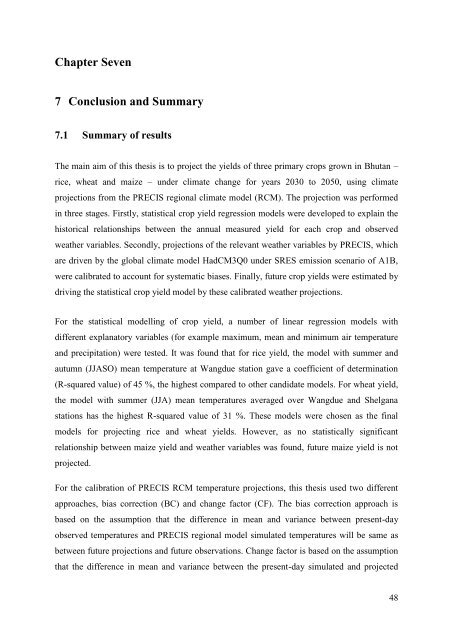UNIVERSITY OF READING - E-Library - WMO
UNIVERSITY OF READING - E-Library - WMO
UNIVERSITY OF READING - E-Library - WMO
You also want an ePaper? Increase the reach of your titles
YUMPU automatically turns print PDFs into web optimized ePapers that Google loves.
Chapter Seven7 Conclusion and Summary7.1 Summary of resultsThe main aim of this thesis is to project the yields of three primary crops grown in Bhutan –rice, wheat and maize – under climate change for years 2030 to 2050, using climateprojections from the PRECIS regional climate model (RCM). The projection was performedin three stages. Firstly, statistical crop yield regression models were developed to explain thehistorical relationships between the annual measured yield for each crop and observedweather variables. Secondly, projections of the relevant weather variables by PRECIS, whichare driven by the global climate model HadCM3Q0 under SRES emission scenario of A1B,were calibrated to account for systematic biases. Finally, future crop yields were estimated bydriving the statistical crop yield model by these calibrated weather projections.For the statistical modelling of crop yield, a number of linear regression models withdifferent explanatory variables (for example maximum, mean and minimum air temperatureand precipitation) were tested. It was found that for rice yield, the model with summer andautumn (JJASO) mean temperature at Wangdue station gave a coefficient of determination(R-squared value) of 45 %, the highest compared to other candidate models. For wheat yield,the model with summer (JJA) mean temperatures averaged over Wangdue and Shelganastations has the highest R-squared value of 31 %. These models were chosen as the finalmodels for projecting rice and wheat yields. However, as no statistically significantrelationship between maize yield and weather variables was found, future maize yield is notprojected.For the calibration of PRECIS RCM temperature projections, this thesis used two differentapproaches, bias correction (BC) and change factor (CF). The bias correction approach isbased on the assumption that the difference in mean and variance between present-dayobserved temperatures and PRECIS regional model simulated temperatures will be same asbetween future projections and future observations. Change factor is based on the assumptionthat the difference in mean and variance between the present-day simulated and projected48
















